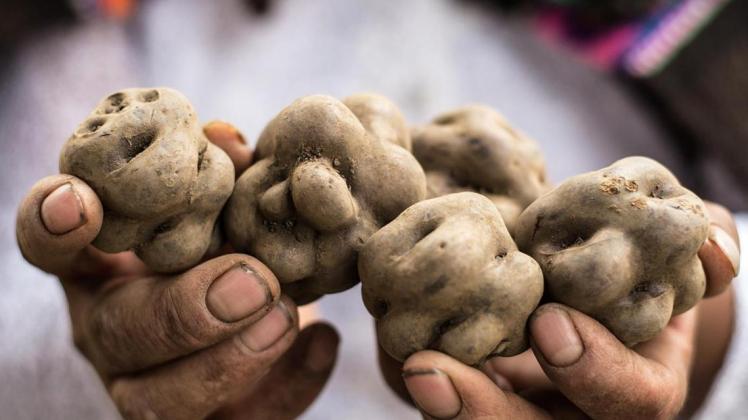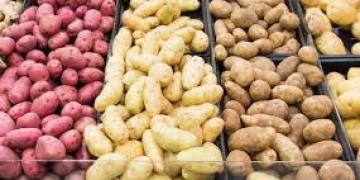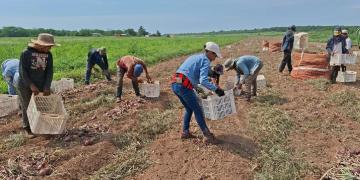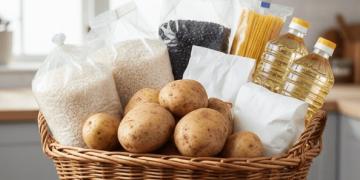Generalidades: How the humble potato changed the world
A staple food for cultures across the globe, the tuber has emerged as a nutritional giant and the friend of peasants, rulers and sages. Even today, its possibilities are endless.

By Diego Arguedas Ortiz
3 March 2020
In his 1957 essay collection Mythologies, the French philosopher and literary critic Roland Barthes called chips (la frite), a food that comes from a crop native to the Americas, “patriotic” and “the alimentary sign of Frenchness”.
Despite its origins in the Andes, it’s an incredibly successful global food
Just a century earlier, a potato disease prompted a famine that halved Ireland’s population in a few years, producing a decades-long cascading effect of social and economic turmoil. And as you read these lines, the world’s leading potato producers today are China, India, Russia and Ukraine, respectively.
Despite these nations’ intimate and complicated relationships with potatoes, and how intertwined their societies and economies are with them, none can truly call them native. The humble potato was domesticated in the South American Andes some 8,000 years ago and was only brought to Europe in the mid-1500s, from where it spread west and northwards, back to the Americas, and beyond.
“Despite its origins in the Andes, it’s an incredibly successful global food,” said food historian Rebecca Earle, who’s tracing the potato’s planetary journey in a forthcoming book called Feeding the People: The Politics of the Potato. “It’s grown practically everywhere in the world, and practically everywhere, people consider it one of ‘our foods’.”
For the rest of the world beyond the Andes, the potato might not be autochthonous, but it feels local. Earle calls it the “world’s most successful immigrant”, as its origin has become unrecognisable for producers and consumers everywhere. Idaho farmers in the US and gnocchi-loving Italians will claim the potato as much as any Peruvian, because its story is not only that of a country or of a region, but an account of how humans have reconfigured their relationship with land and food within a few generations.
You may also be interested in:
• Asia’s ‘anti-ageing red diamond’
• The birthplace of the modern apple
• A foraged green that can kill
The potato is the world’s fourth-most important crop after rice, wheat and maize, and the first among non-grains. How could an Andean tuber persuade the world, in just a few centuries, to adopt it so completely? What made the potato so irresistible was its unrivalled nutritional value, its relative easiness to cultivate as compared to some major cereals, its ability to easily navigate wars and tax censuses due to its knack for hiding underground from collectors, and in particular, its camaraderie with working men and women in the fields.
A good place to understand its origins is the Centro Internacional de la Papa (CIP), or International Potato Center, a research-for-development centre that researches and promotes all things potato-related.
It’s set in an arid suburb in the Peruvian capital, Lima, and harbours a collection of thousands of potato samples from across the continent. “The Andes is where the biggest genetic diversity lies, but you can find potatoes from Chile to the United States,” René Gómez, senior curator at the CIP genebank, told me there.
He explained that potatoes were domesticated high in the Andes, near Lake Titicaca, nearly 1,000km south-east of Lima. Following domestication, these early potatoes spread through the cordillera and became a crucial food supply for indigenous communities, including the Inca, particularly as a staple foodstuff called chuño, a freeze-dried potato product that can last years or even decades.
Out of the Americas
In 1532, the Spanish invasion brought an end to the Inca but not to the cultivation of potatoes. The invaders took tubers (the underground parts of the plant we call potatoes) across the Atlantic, as they did with other crops such as tomatoes, avocados and corn, in what historians call the Great Columbian Exchange. For the first time in history, the potato ventured beyond the Americas.
These early Andean varieties had a tough time adjusting to Spain and other parts of mainland Europe. Day length is very constant across the year in the equatorial region where potatoes first were domesticated, so the potato plant was used to regular days with 12 hours of sunlight, said evolutionary geneticist Hernan A Burbano Roa.
European long summer days confused the potato plant, and tubers didn’t grow during the favourable warmer months; instead, they did so in the autumn, too close to the frosty early winter days to survive. The first decades of planting in the Old Continent proved unsuccessful.
But then potatoes found better conditions in Ireland, where a cool but frost-free fall gave the crop enough time to mature after its introduction from Spain in the 1580s. A century of farmer selection produced a variety that set tubers earlier in the summer, and the potato took the mantle it would carry for centuries: the staple crop of peasants.
The humble tuber
Villagers prized potatoes because they provided an unmatched nutritional yield per hectare. In Ireland in particular, tenants rented the land they tilled, so as lords increased their fees, they were forced to produce as much food as possible in the smallest possible area. “No crop produced more food per acre, demanded less cultivation and stored as easily as the potato,” wrote sociologist James Lang in his book Notes of a Potato Watcher.
Potatoes contain nearly every important vitamin and nutrient, except vitamins A and D, making their life-supporting properties unrivalled by any other single crop. Keep their skin and add some dairy, which provides the two missing vitamins, and you have a healthy human diet staple. You even have 2g of protein for every 100g of potato; eat 5.5 kilos per adult per day, if one’s to believe some estimates of consumption in mid-1600s Ireland, and you have a good supply.
For landless tenants in 17th- and 18th-Century Ireland, a single acre of land cultivated with potatoes and one milk cow was nutritionally sufficient for feeding a large family of six to eight. No cereal could claim that feat. Thus, began the centuries-long captivation among Irish and British peasants with the potato, grounded in rented earth and scarcity.
From the British Isles, potatoes spread eastwards across peasant fields in Northern Europe, writes Lang: they were found in the Low Countries by 1650, in Germany, Prussia and Poland by 1740 and in Russia by 1840s. After farmer-selection filtered out those varieties and genes less adapted to local climate conditions, it flourished.
Villagers in the war-ravaged European plains, by conflicts such as the War of the Austrian Succession and the Seven Years’ War, quickly discovered another advantage of planting potatoes: they were really hard to tax and plunder. “If you have a field of wheat, it’s really visible. You can’t hide it”, said Earle, who claims tax collectors can visually measure their size and return in time for the harvest. But underground potatoes are well hidden, and you can dig them up one by one, as needed. “Such piecemeal harvesting hid the crop from tax collectors and protected the peasant’s food supply in the war time,” said Lang in his book. “Marauding soldiers laid waste to field crops and raided grain stores. They rarely stopped to dig up an acre of spuds.”
The elites and military strategists of the time noticed this. Prussia’s King Frederick the Great ordered his government to distribute instructions on how to plant potatoes, hoping peasants would have food if enemy armies invaded during the War of the Austrian Succession in 1740. Other nations followed suit and by the time of the Napoleonic wars in the early 1800s, the potato had become Europe’s food reserve, according to a report by the Food and Agriculture Association of the United Nations (FAO).
In fact, tubers were such a valued crop during wartime that “every military campaign on European soil after about 1560 resulted in an increase in potato acreage, down to and including World War Two,” wrote historian William McNeill in his 1999 essay How the Potato Changed the World’s History.
Nutrition and power
In a matter of centuries, potatoes entered the European and global economies as a staple crop. For decades, food historians (such as those noted in this FAO booklet from 2008) have explained this spread as the result of well-meaning Enlightened sages obsessed with the nutritional properties of the tubers that managed to persuade a reluctant and conservative populace to adopt the potato.
But Earle has her doubts. It was peasants who adapted the potato to Europe, she argues, thus they needed no persuading. Elites did not discover a new crop, but rather, they had a novel idea of what healthy food was. Instead of placing a “superfood” in the middle of European diet, they realised that nutrition needed to take a more central role and looked around for those crops that might serve their purpose. The humble tuber was already there.
Enlightened discussions of “population”, and what its health meant for the power of the state, changed political calculations during the 18th Century, and also the fortunes of the potato. If a strong, numerous population was crucial for economic production and military might, the state needed to understand and manage the nutritional components of what people were eating. Abundant, healthy food became central to Empire-building, Earle writes in her 2018 paper Promoting Potatoes in Eighteenth-Century Europe. Thus, she argues, the fascination with potatoes does not come from the emergence of a new crop, but from novel European ideas of the relationship between food and the state.
In this regard, the potato was unrivalled. “The food produced by a field of potatoes is… much superior to what is produced by a field of wheat,” wrote Adam Smith in The Wealth of Nations. “No food can afford a more decisive proof of its nourishing quality, or of its being peculiarly suitable to the health of the human constitution.” But while Smith was right in highlighting the potato’s virtues, it was peasants and not the elites that made potatoes a fixture of European gardens and farms.
A question of measuring arises, Earle admits. How did scholars like Smith and his contemporaries compare nutritional value? In the 18th Century, scientists hadn’t agreed on a language for vitamins, proteins and minerals, she said. Instead, “what they did is say: ‘look at the people who eat potatoes. They are more robust, and they are stouter and more energetic than people who eat other things’,” said the scholar, who heads the Department of History at the University of Warwick.
But as she argues, potatoes served this state-building purpose not only because of their nutritional value, but because they were already planted in gardens and fields across the continent. Its fans praised its virtues.
Potatoes, by feeding rapidly growing populations, permitted a handful of European nations to assert dominion over most of the world
They were not wrong. A widely cited economics paper reviewed information from military records of French soldiers born after 1700 and showed that eating potatoes made people slightly taller. According to The Quarterly Journal of Economics: for villages that were fully suitable for potato cultivation, its introduction increased average adult heights by approximately one-half inch.
That same paper provides a stronger claim: that population in Europe and Asia exploded after the spread of the potato. According to the researchers, the tuber introduction accounts for close to one-quarter of the growth in Old World population and urbanisation between 1700 and 1900.
“Potatoes, by feeding rapidly growing populations, permitted a handful of European nations to assert dominion over most of the world between 1750 and 1950,” wrote McNeill.
Back to the Andes
The potato frenzy continued unstoppably until a blight paved the way for the Great Famine of 1845-1849 in Ireland. The failure of the crop, compounded by the utterly inadequate response by the British Government in London (which decided against relief and bet on market forces), led to the death of a million people, the emigration of one million people to the US and the steady departure of two more million elsewhere. Ireland’s population was halved in a matter of decades.
The Famine called attention to the fact that potato had supplied 80% of calorie intake in the country with only a handful of crop varieties available. Such a homogenous food block made the potato susceptible to diseases, as its genetic diversity had been washed away from domestication.
To be fair, some mixing of varieties had already taken place in Europe around the 1750s. Burbano was part of a team that peered into the genes of European potatoes to study their ancestry and concluded that ancient Andean varieties mixed with tubers later brought from the lowlands of south-central Chile, such as Chiloé island, were naturally domesticated for the long days of the Southern Hemisphere.
This first admixture only provides some handy traits, but not enough genetic depth, so breeding programmes over the years have been looking at ways to improve food security for potato farmers. “One of the ways breeders used to incorporate resistance was looking at wild potatoes,” Burbano explained, talking about inedible potato cousins that still survive in the Andes and in the rest of their natural range. There are 151 known species, and they are the ancestors of today’s potatoes, which have lost genetic diversity after centuries of serving humans.
In the early decades of the 20th Century, scientists began combining genes from mainstream potatoes, hoping to keep their domesticated traits, with wild potatoes, hoping to get their resistance to diseases. Most tubers grown today are a result of such tests.
These wild species might also provide an answer to another pressing issue: changing temperature and rain conditions due to the climate crisis. A recent study concluded that rising emissions could cause a reduction of up to 26% of global tuber yield reductions by 2085. Genetic resources from these species could provide desirable traits, such as tolerance to frost, drought or temperature increase.
Breeders in Europe and the United States, and more recently in Asia, have been developing these more resistant varieties for years, paving the way for potatoes to become a truly global crop in the 20th Century. Of the world’s top 20 tuber producers, only three (the United States, Peru and Brazil) are part of its historical range, but every country is creating its own connection to it.
In China, the government is aggressively promoting the potato among its population, hoping it can become a new national staple crop and staple food. Its leaders are following similar tactics to those of 18th-Century Europe, peddling it with state-owned media, popular figures and popular science books. And in India, potatoes are prepared in hundreds of different ways and you would struggle to convince farmers that they aren’t local.
Top chefs like Virgilio Martinez are featuring different varieties of potatoes in their creations (Credit: Credit: Everett Collection Inc/Alamy)
Top chefs like Virgilio Martinez are featuring different varieties of potatoes in their creations (Credit: Everett Collection Inc/Alamy)
Half the world around, the potato has reignited long-standing rivalries between Peru and Chile over who can claim the tuber as their own, while top chefs in Lima and the Andes – such as Virgilio Martinez who opened Mil in 2019 – are turning their gaze again to potatoes and featuring them in their creations.
While Peruvians insist that potatoes were domesticated in what’s now their territory (and bits of neighbouring Bolivia), a Chilean minister countered in 2008 that a vast majority of the world’s tubers come from a variety introduced from Chile. But the debate is not necessarily about a history lesson, but also about national pride. “The silly part is that the story of the potato began millennia before the concept of nation-states existed,” said Charles Crissman, a researcher at the International Potato Center, in a New York Times story published in 2008. “But, yes, the first potatoes came from what is today Peru.”
The claims rankled Peruvians because it came during the International Year of the Potato in 2008, a celebration that even FAO conceded “came from the Government of Peru”. The country established the International Potato Center in 1971 and worked with indigenous communities in the mountain peaks to protect the potato’s genetic heritage.
A small agri-park high in the Peruvian Andes, the Potato Park in Cusco harbours a living museum of the humble tuber, in their natural environment, a reminder of where the potato comes from, but also a roadmap of where it could go: genetic material from less domesticated potatoes can trace a path forward for the crop, as it deals with new threats such as changing climates and pressures on the agricultural sector.
A two-hour drive east of Cusco, a different view of the present and the future awaits: it’s Mil, an ambitious take on Peruvian culinary tradition perched 12,000ft up in the clouds of the Andean mountains. Thanks to its celebrated chefs, here you can try a handful of Peru’s almost 5,000 species of potatoes, and still have some space to wonder about what’s beyond these mountains: is it an Indian curry? Fish and chips in an east London pub? A baked potato fresh from an Idaho oven?
With the global versatility of potatoes, the possibilities are endless.
Culinary Roots is a series from BBC Travel connecting to the rare and local foods woven into a place’s heritage.
Join more than three million BBC Travel fans by liking us on Facebook, or follow us on Twitter and Instagram.
If you liked this story, sign up for the weekly bbc.com features newsletter called "The Essential List". A handpicked selection of stories from BBC Future, Culture, Worklife and Travel, delivered to your inbox every Friday.
Fuente:




